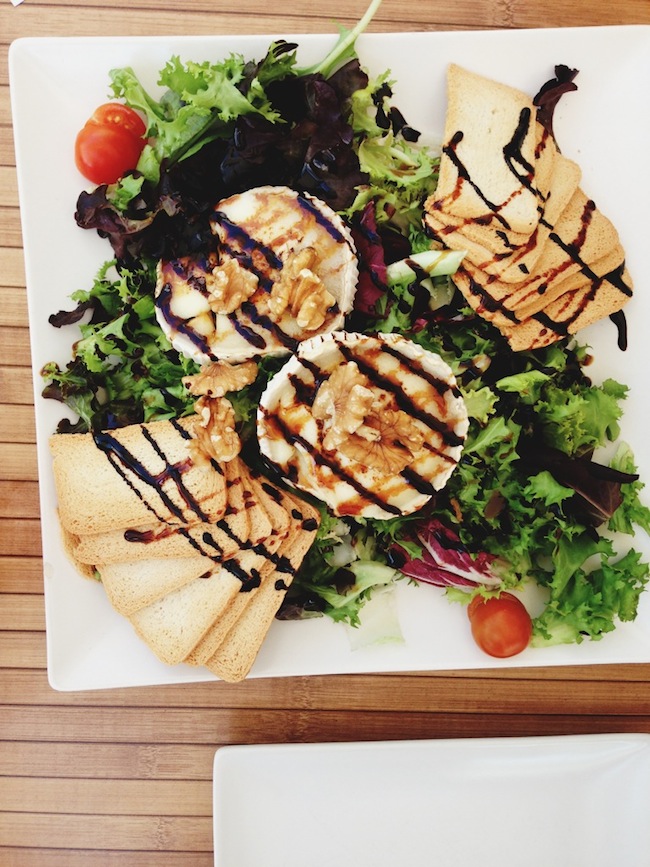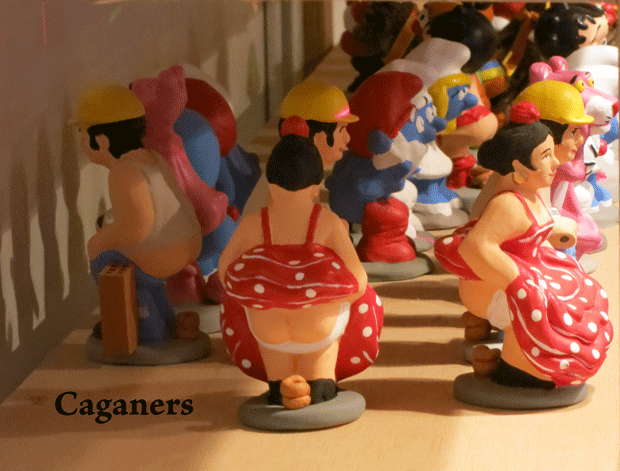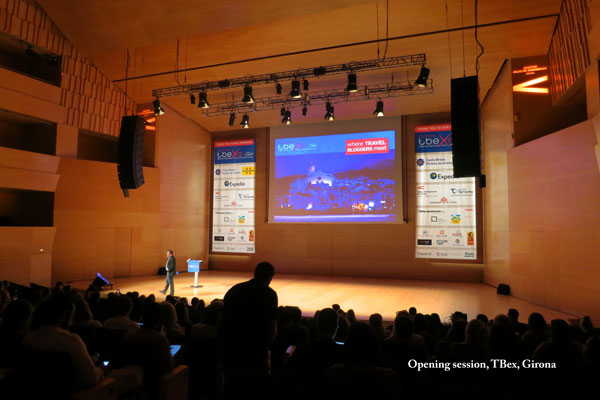In a serendipitous twist of fate, a dream from the past and a series of uncanny synchronicities lead Elyn Aviva and her husband, Gary, back to Girona, Spain. Amidst the charming medieval streets, they feel at home in ways they don’t quite understand. The journey rekindles Elyn's passion for a long-abandoned novel, and though it remains unfinished, they trust that life's purpose will be revealed.
All tagged Spain
Hire the Grandmothers
In this essay, Gary White explains how he and his wife use spiritual guides called "the Grandmothers" for assistance in their journeys. When Gary and his wife ask the Grandmothers to facilitate an easy transition from Portugal to Spain, they are astounded by the results.
Food Sharing, Barcelona Style
Some people love to share their food. Kristine Mietzner, not so much. Then a Barcelona food tour changed everything.
Flamenco and the Art of Emotion
During a visit to Madrid, Spain, Melissa Paquette attended a flamenco show. Just as the first performance ended, a baby in the audience began to cry. Little did she know it, but the baby wouldn't be the only one in tears before the night was through.
Fleeing Catalonia
For Elyn Aviva, an American expat living in Catalonia, the Spanish government's heavy-handed response to the October 1st Catalan independence referendum ignited a complex emotional turbulence and the decision to temporarily flee Catalonia.
The Mysterious Living Aqueduct in Spain
A visit to a mineral-springs health spa in southern Spain results in a mysterious sense of relaxation and well-being for Elyn Aviva.
Dragon’s Blood, Books, and Dance in Barcelona
Barbara Wysocki celebrates Catalonia's patron saint in Barcelona on a day that also recognizes a noble dragonslayer and marks the deaths of two literary lions. With a potpourri of bookish events, roaming musicians, and a chance to dance, she gets swept into the magic of past and present.
My Journey to the Union of Heaven and Earth
by Elyn Aviva
Join me on a journey into the unknown, where what you think you know melts away and is replaced by something—something “bigger.”
For decades I have been drawn to sacred sites and powerful places, drawn to go on pilgrimage across France and Spain, drawn to place my feet in the footsteps of if not my ancestors then of the ancestors of spirit who have traveled these paths before me. Like iron pulled toward a magnet, I have sought out well- and little-known places of power—ancient stone circles, half-buried dolmens, ruined Romanesque chapels, spire-topped inspiring cathedrals, thick forests, hidden holy wells, dark sacred caves. Seeking I knew not what, going I knew not why, except that I was driven by a simple but all-consuming question: “What are these places?” I think I hoped that, by going to enough of them, I would find the answer.
I am sure you’ve heard that Spanish food is incredible, that it’s unlike anything you’ve ever tasted, that it’s innovative and bright and well, you know – all that hype. Here’s the thing. It’s totally true. Unfortunately, it took me a good two years of living in Spain to realize it.
Let me back up a bit. I moved to Spain on the premise of staying for nine months – just enough time to explore Europe and sink my teeth into Spain before heading back home. My first day in Spain, I was all alone. I hadn’t made friends yet, but that clearly had no effect on my hunger, and I walked into a little bar to order a sandwich. Now a sandwich in the United States is a hefty sort of thing, layered with ingredients and toppings and sauces. And as I was fairly hungry when I ordered this “sandwich,” I was more than disappointed when two flimsy toasted pieces of sandwich bread came my way with a little lettuce, tomato and a fried egg stuffed between them.
Okay, so my first experience wasn’t great, but over time I did learn to enjoy Spanish food. I liked it. I really liked it. But I never reached the point of loving it. I continued ordering the same things again and again at restaurants and bars, and never felt it was special. In my head, American food was superior to the simple and often bland food of Spain.
About a year and a half after I moved to Spain, I met my Spanish boyfriend, and I decided to tell him my opinion about all of this. He was shocked. I thought he was too proud to admit I was right, but I realize now I was horribly mistaken. As we continued dating, I started tasting foods I had never even heard of before, and I had to come to terms with the fact that after eighteen months of eating three meals a day, I actually knew nothing about Spanish food. Actually, my realization was an epiphany.
Seeking Retreat in Asturias, Spain
by Elyn Aviva
I needed a break. Big time. I’d been doing too much for too long. Traveling. Writing. Doing. Coming up with projects, ideas. More doing. And doing some more. I loved it all, and I loved my husband, Gary, but I needed a break. Alone. And somewhere preferably in Spain, where we live.
by Jessica Kitt
When I moved to Barcelona, my knowledge of Spanish music was as narrow as that of most expats travelling to Spain: flamenco, castanets, and … flamenco? However, as my two-year journey throughout the country proved, there is a lot more to Spanish music than just flamenco. My first partial relief of ignorance came from a student I was teaching from the region of Asturias in the North of Spain. After about the first year of teaching British English classes in Spain, I developed a certain odd nostalgia for home and my Irish heritage.
Coming from quite a traditional background, with a family of musicians and Irish dancers, I was used to being surrounded by all things Irish. Frequently, I took to listening to my father and uncle’s traditional Irish band on my MP3 player before bed. One day, during a class with my Asturian student, I indulged in a discussion about Irish music and all the “exotic” instruments we had from uilleann pipes (Irish bagpipes) to bodhrans (hand held drums). During this discussion, my student informed me that the music of both Asturias and Galicia in the North is Spain was surprisingly similar to both Irish and Celtic music. I promptly downloaded some of this music and was shocked by how similar it was.
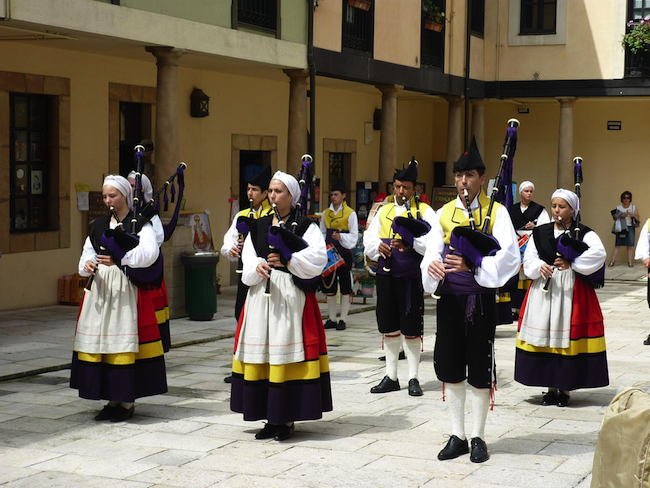 Traditional Asturian drummers and pipers. Photo by austinevan via flickr ccl.
Traditional Asturian drummers and pipers. Photo by austinevan via flickr ccl.
This similarity between Irish and Northern Spanish music was again proven to me when I travelled to the North of Spain to work on an organic farm for a month.
by Elyn Aviva
Rumbling vibration of Spanish high-speed AVE train, coming into the deep underground white glass-brick cement plaster metal station in Girona. Feet tingle on platform, train sloowwwwws waaaayyyyyyy dowwwwwwnnnn and coasts to stop. Sigh like a long-held outbreath as doors open, stairs unfold. Clack thump of discharging passengers maneuvering out and down and onto platform, luggage dangling.
We wait to get on. Impatience has a metallic feel.

Finding our seats, sinking in. Ahh. Whoosh of doors closing, train starting, gaining speed. 200 kms/hour. Fast. Train car is more or less silent, except for the gaggle of girls behind us, a before-wedding hen party heading to Barcelona. They sport puffy red heart pins on their sweaters, move grudgingly when I push through to the semi-circular toilet cubicle at the end.
Ground mist rises like whipped cream, hiding the dark green hills. Rain smears against the windows, streams rushing tumultuous but soundless, muddy swirling water caressing tree roots in a cold embrace.
200 kms/hour, now 150, now 50, now 6…. Slow sigh of arrival. Sants Estación, Barcelona. Hurry down the platform, up the escalator, across the station toward Metro entrance. Huge Metro map on wall, angular routes snaking over it, marking the underground root-network beneath the city. Choose your color, your number, your direction. Linea 5, sky blue, direction Vall de Hebron, intermediate node, Sagrada Familia. Repetitive thump squeak of footsteps on tile corridor, down one flight of stairs, onto slow moving escalator… Pause. Shift. Wait.
Tension builds. People jostle to buy tickets. Which way does the ticket arrow go in the machine to get through the gate? Will the baby buggy get caught in the vertical gyrating windmill turnstile? Why doesn’t it work? Put it in again. Lose a journey.
Have a Happy Crappy Christmas Catalonia-Style
by Elyn Aviva
Bon Nadal and Feliç Any Nou! That’s Catalan for Merry Christmas and Happy New Year.
It’s the holiday season in my home town, Girona, Catalonia, and things aren’t quite what you might expect. Yes, there are the familiar ho-ho-ho Santa Claus figures dangling from buildings, and three-foot-high Christmas trees with matching pink and purple ribbon decorations are lined up outside stores on the main shopping streets.
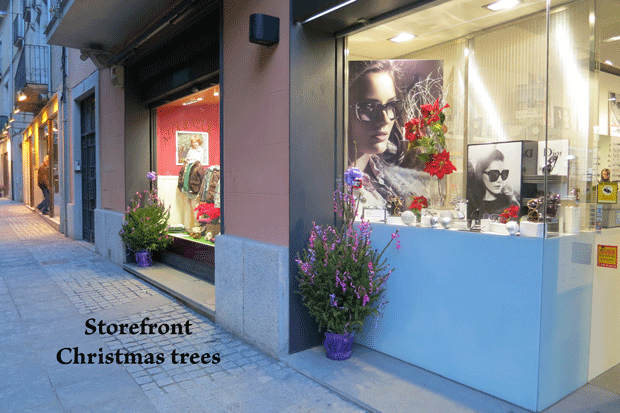
There are brilliant-colored lights strung across the avenues, and a glittering conical abstraction of a Christmas tree pulses on and off in the Plaza de Catalunya. Christmas carols (sometimes in English) echo through the halls, the beauty salons, and the restaurants, and carolers emote as they stroll down the pedestrian Rambla, songbooks in hand. Flame-red poinsettias are for sale in the market, and school-club fundraisers hawk chocolate bars and handmade knickknacks. And there’s the cheery Firanadal (Christmas Fair) offering artisanal goods, felt slippers, jewelry, plastic toys, and boxwood spoons.
Yes, all of this is vaguely familiar, even if gigantes (giant dancing king and queen figures), a marathon Nativity play (Els Pastorets), xuixus (pronounced “choochoos”: sugar dusted, cream-filled pastry rolls), and turrón (a kind of nougat) aren’t usual Christmas fare.
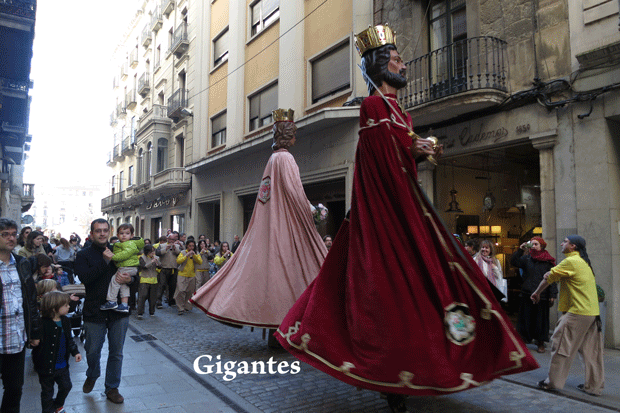
But you really know you’re in a foreign land when you seen the rows of squatting miniature figures—including SpongeBob SquarePants, flamenco dancers, Obama, Barça soccer star Messi, Queen Elizabeth II, and Death—their pants pulled down, a brown plop of poop deposited behind them, for sale for inclusion in Nativity scenes. Correction: the plop of poop behind Death is white, not brown.
by Elyn Aviva
Unwittingly, my husband, Gary, and I walked into an alternative virtual reality. We were surrounded by aliens who looked human. Aliens who spoke a language that sounded like English, but their vocabulary was subtly different. Words like “ROI,” “SEO,” and “hashtags” peppered their speech.
And they communicated with odd body language. Although they seemed to be talking to each other, they rarely made eye contact. Instead, they stared intently at small, vibrating, hand-held devices with brightly lit screens. And they kept tapping these strange pieces of equipment, sometimes with one finger, sometimes with several, or sometimes with their opposable thumbs. Occasionally, their eyes flicked up from the screen to glance around. But only for a moment.
Into what strange world had we wandered? An international travel bloggers conference in Girona, Catalonia, Spain. It sounded appealing in the invitational email: inexpensive, educational, entertaining—and it included a visit to a castle. AND it was taking place in my adopted home town of Girona, so why not?
In this alternative universe, everything was baffling, including the meaning of words I thought I knew. “Relevant” meant “meeting your fans where they’re at” and “content” meant maximizing your Google indexability (the number of searchable key words in your website or blog). “Service” writing” meant providing information and the rush to publish meant some bloggers are posting not weekly but daily or even hourly. A popular book author was called a “long-form print guy.” “Engagement” referred to how actively engaged your Facebook (or blogsite) fan base is, not to a diamond ring.
by Elyn Aviva
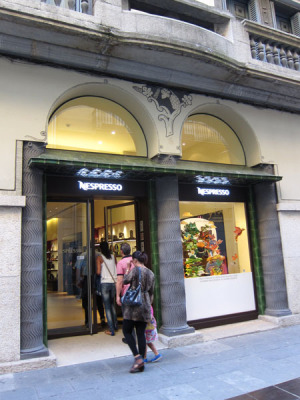 When we went for an early morning stroll in Girona, Catalonia, my husband, Gary, and I saw a group of well-dressed people standing impatiently outside a shop. We took a closer look and saw a storefront with impressive, fluted grey stone columns, large display windows, and imposing glass double doors. The merchandise on display was unusual: small metallic capsules in coordinated colors arranged in geometric designs. Emblazoned in glowing white letters over the doors was “Nespresso.” Nespresso? The coffee capsule brand?
When we went for an early morning stroll in Girona, Catalonia, my husband, Gary, and I saw a group of well-dressed people standing impatiently outside a shop. We took a closer look and saw a storefront with impressive, fluted grey stone columns, large display windows, and imposing glass double doors. The merchandise on display was unusual: small metallic capsules in coordinated colors arranged in geometric designs. Emblazoned in glowing white letters over the doors was “Nespresso.” Nespresso? The coffee capsule brand?
The crowd grew increasingly noisy and impatient. We decided it was time to leave before they became even more restive.
I was puzzled. Who would want to purchase pre-made coffee capsules? It seemed neither cost-efficient nor ecologically sound. And besides, when you ran out, there was nothing you could do—except wait desperately for the Nespresso shop to open.
Returning from our stroll, we paused again at the shop. Nespresso was its name and luxury was its selling point. From our vantage point we could see inside. Slim young women in classy matte-black uniforms stood near the open door, gatekeepers into this exclusive club. People entered, sometimes showed a membership card, chatted for a moment discreetly, and then were ushered into this high temple of gustatory excess.
Two Ex-Pats in Girona, Catalonia
words + photos by Elyn Aviva
“I can’t believe we live here!” I said to Gary as I stared in fascination at the multicolored reflections dancing over the rippling surface of the Onyar River.
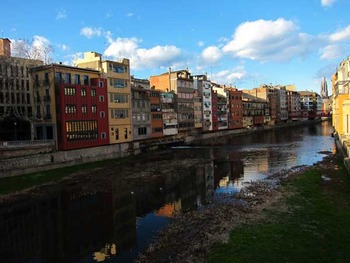 River OnyarHe squeezed my hand and leaned over the railing of the stone bridge. Ducks floated by, luminous in the evening light. “I know just what you mean,” he replied. “Who’d have thought that what started off as a whim would end up being such an adventure?”
River OnyarHe squeezed my hand and leaned over the railing of the stone bridge. Ducks floated by, luminous in the evening light. “I know just what you mean,” he replied. “Who’d have thought that what started off as a whim would end up being such an adventure?”
I nodded, admiring how the brightly lit cathedral spires were silhouetted against the velvet black sky. I sighed, contentedly. Then, hand in hand, Gary and I strolled across the medieval bridge that divides one part of Girona from the other. We walked down the Rambla and sat down at a sidewalk café. We ordered a cortado, a fragrant cup of espresso laced with a touch of milk, and an artisan beer. We looked at each other and grinned. Ah, what a life.
Just two years earlier Gary and I had been pondering what to do next with our lives. We knew we enjoyed traveling in Europe and wanted to do more of it with less hassle. Why not move to Europe for a few years, I suggested. We weren’t getting any younger. We had good health, enough money, a love of adventure, and much to be grateful for. If not now, when? Gary agreed, and we began making plans to move to Spain, a country we had lived in briefly once before.
by Elyn Aviva
I don’t know what I was thinking. Or rather, I wasn’t thinking. Like a lamb being led to slaughter, I followed our friend Jack into Oriol Balaguer’s chocolate kitchen in Barcelona. I knew I was a dead duck the moment I walked in. The sweet spicy scent of Gran Cru chocolate filled the air, and streams of satiny liquid chocolate poured exuberantly into stainless steel sinks. It was like being transported into paradise.
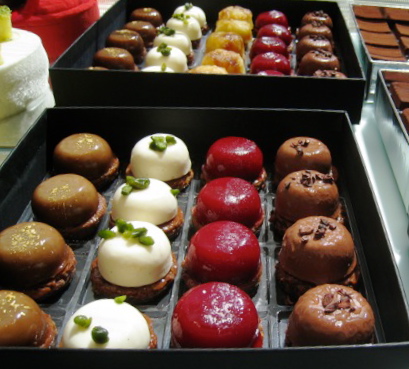 It’s true confession time. I used to belong to a Chocoholics Club. Note the operative verb: “used to.” Once a month, one of the members would make an over-the-top chocolate dessert, which we would savor briefly and then devour. Devotees of chocolate we were—and some of them still are. For health reasons, I had sworn off the dark, creamy, butter-and sugar-laden delights. And, except for an occasional lapse, I usually avoided succumbing to temptation.
It’s true confession time. I used to belong to a Chocoholics Club. Note the operative verb: “used to.” Once a month, one of the members would make an over-the-top chocolate dessert, which we would savor briefly and then devour. Devotees of chocolate we were—and some of them still are. For health reasons, I had sworn off the dark, creamy, butter-and sugar-laden delights. And, except for an occasional lapse, I usually avoided succumbing to temptation.
So what was I doing in Balaguer’s High Temple of Chocolate? Jack (www.discovergirona.net) leads specialty tours in Catalonia, and the opportunity to do an interview with master chocolatier/pastry and dessert chef Oriol Balaguer was too good to pass up. I hadn’t considered the consequences—but now I knew. I knew I would live to regret it—but I also knew, as I took another deep, soul-satisfying inhalation, that I didn’t care.
Oriol has been winning prizes for his chocolate and pastry creations for the last 17 years—and he’s only 39. Best Pastry Chef, Best Book (The Dessert Book) in the World, Professional of the Year—the accolades don’t stop. Not only is he a brilliant inventor, he’s also a master marketer. He’s turned buying chocolate into a time-valued event.
When is chocolate like haute couture? When you are Oriol Balaguer and you present twice-a-year collections of new tastes, textures, and shapes. Last season’s collection is so last year—but so good that it is still available and still in great demand. Oriol also launches monthly “concept cakes” in his specialty shops, where each item is displayed like a precious jewel. Suddenly, everyone wants to purchase the latest product, score the most recent release for their dinner party.
I fell in love with Spain. First it was a week in Barcelona, then, a year later, a week in Madrid. By year three, following a week’s tour in the Midi-Pyreees, I couldn’t resist the opportunity to return to Spain and travel its length from Bilbao in the north, through its geographic center of Madrid and on to the former Moorish capital of Granada in the south. But first, I was told, I must visit – and eat in – San Sebastian.
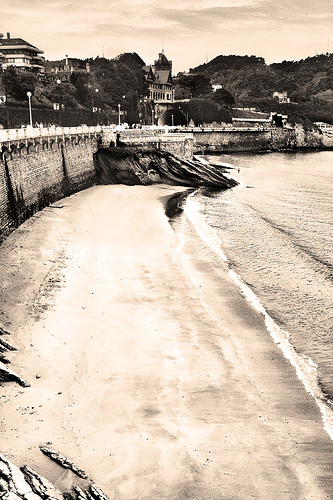 by SwansonRut via flickr (common license)Located on the eastern end of Spain’s Atlantic coast, known as la Golfo de Vizcaya (Bay of Biscay), San Sebastian is considered one of the culinary capitals of the world, a distinction largely lost on this non-foodie. But, as much as gourmandizing does not excite me, the idea of bars competing to outdo each other with exotic and cheap finger food called “pintxos” (pronounced “pinchos,” and essentially tapas) was an adequate inducement, along with San Sebastian’s picturesque setting in a horseshoe-shaped bay with golden sand beaches.
by SwansonRut via flickr (common license)Located on the eastern end of Spain’s Atlantic coast, known as la Golfo de Vizcaya (Bay of Biscay), San Sebastian is considered one of the culinary capitals of the world, a distinction largely lost on this non-foodie. But, as much as gourmandizing does not excite me, the idea of bars competing to outdo each other with exotic and cheap finger food called “pintxos” (pronounced “pinchos,” and essentially tapas) was an adequate inducement, along with San Sebastian’s picturesque setting in a horseshoe-shaped bay with golden sand beaches.
I arrived by train from Toulouse, France, with the rugged Pyrenees providing a continual and stunning southern vista. At the border city of Irun, Spain, the civility and cleanliness of the French train, with the melodious lilt of that language spoken in hushed tones, was markedly replaced by a grimy and worn Spanish train, boarded by shoving one’s way in, and the shouts and grunts in Spanish and Euskara, a baffling pre-Indo European language spoken by the Basque people in northeastern Spain. I was back.
San Sebastian’s seaside does not disappoint. Its broad promenade skirts the entire bay where locals and tourists of all ages, most smartly dressed, stroll arm-in-arm or glide by on bicycles or skateboards. White walled restaurants with royal blue awnings and outdoor seating offer exceptional people-watching opportunities on the promenade or beachside, while upscale apartments and commercial buildings line the boulevard, looking over a green-hilled island and bobbing sailboats to sea.
The Camino de Santiago: An Inner and Outer Journey
by Elyn Aviva
I first heard about the Camino de Santiago in 1981 from my friend Michael, when I was looking for a topic for my Ph.D. in cultural anthropology. Michael idly mentioned there had been an important medieval pilgrimage road in Spain and suggested I look for it—I might find its art and architecture of some interest.
In the summer of 1981 I arrived in Spain, still looking for a topic for anthropological fieldwork. I ended up in Sahagún, a small town in the north-central province of León, where I stayed at the Benedictine nuns’ guesthouse.








